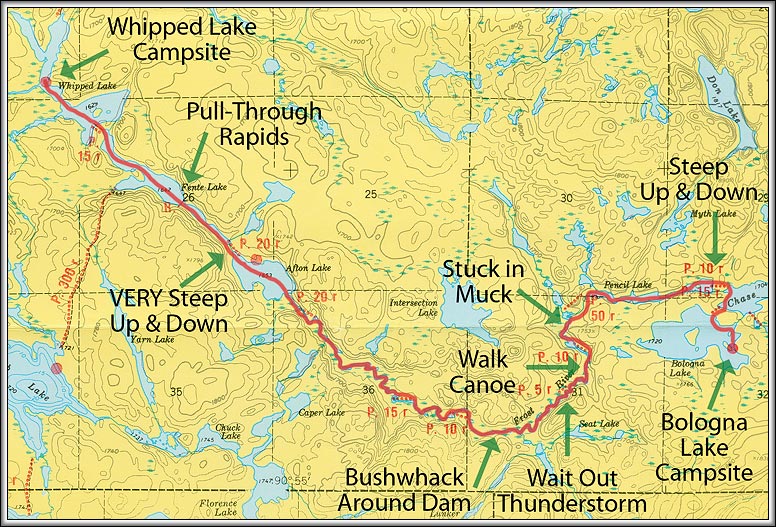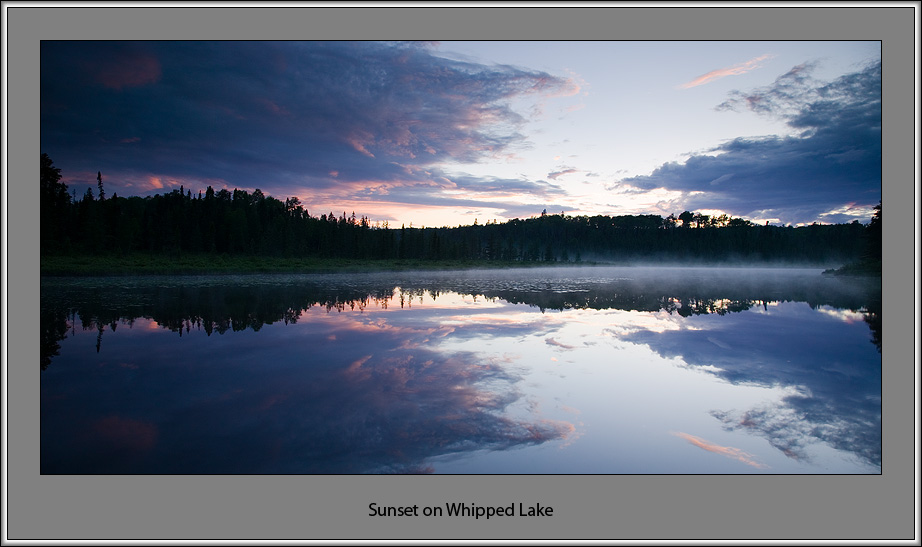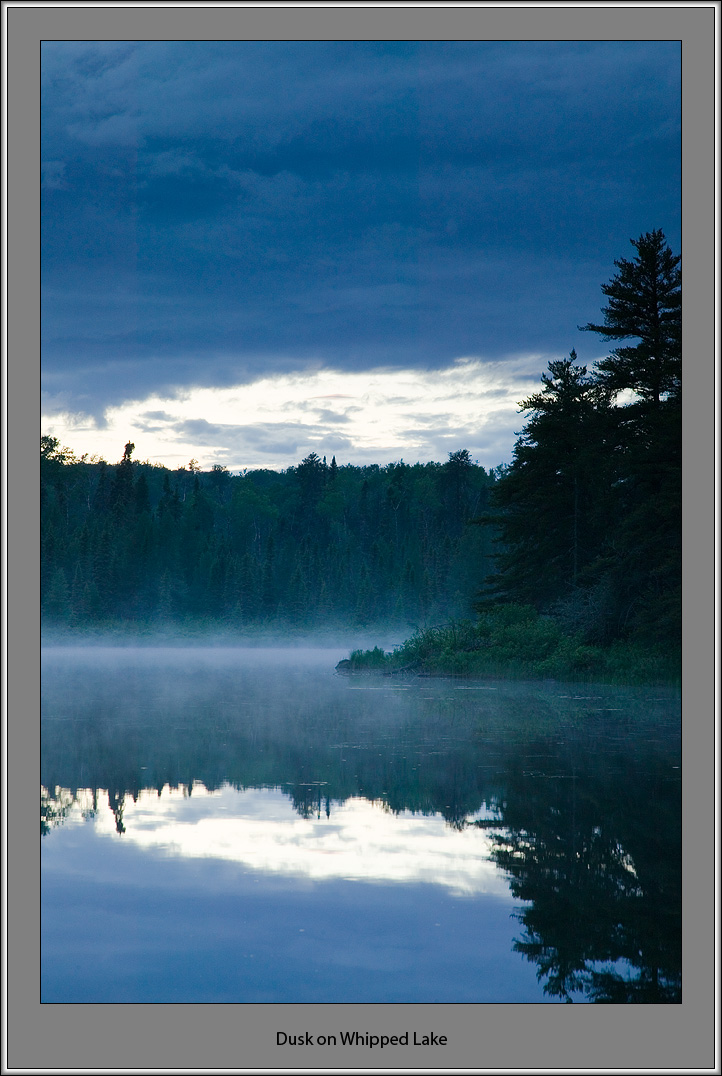| << Prev | Intro | Day 1 | Day 2 | Day 3 | Day 4 | Day 5 | Day 6 | Day 7 | Day 8 | Day 9 | Next >> |
Day 6, Tuesday, June 13 - Bologna Lake to Whipped Lake
Emerging from the tent this morning feels a little different than on previous mornings. The sky is overcast, and the air is heavy with the smell of approaching rain. It's a little past 5:00AM as we pull on our rain gear and race to pack things up. But unfortunately, the rain arrives too fast and catches us before we can finish taking down the tent. It rains hard for a while, and we wait hoping it will subside. Not wanting to delay our start any longer than necessary, however, we finally decide the tent will be wet no matter what we do, so we quickly take it down and prepare to head out in the rain. About half way across Bologna Lake, the sky starts to lighten up (of course!), and by the time we complete the portage into Chase Lake, the rain has stopped.

At the very next portage to Pencil Lake, the sun begins to peek through the clouds. The portage from Chase to Pencil is a steep up and down with a slippery rock face on the down slope. Heidi and I work together to get the canoe over these inclines, and soon we're heading down the aptly named, long and narrow Pencil Lake. The lake is a very pretty one and no doubt great moose habitat, but as usual, the only evidence of moose we see is yet more droppings on the portage at the other end. This portage out of Pencil Lake, at approximately 50 to 60 rods, is the longest of all the marked portages along the Frost River between Frost and Mora Lake. It leads to the next long stretch of river and actually runs along the opposite (south) side of the exiting waterway from the location shown on all the maps. Perhaps the portage was rerouted at some point in the past.
Upon reaching the other side of the portage with my first load, I step to the river bank to put down the canoe, and one leg immediately sinks past the knee into the muck. It takes me a few moments before I realize that it's going to require some real effort to extricate myself from this awkward position. I don't have much to support myself against, and every attempt to pull the leg free is met with an equally formidable counter-force that sucks it back down. I could pull just my foot out, but the last thing I want to do at this point in the trip is lose one of my new Chota Trekker boots. Heidi is still back on the portage somewhere, leaving me alone in this comic predicament. I chuckle to myself as I imagine the headline, "Man Stuck in Muck Trampled by Thirsty Moose". But just before Heidi emerges from the portage, I do manage to wiggle the leg free. I tell her we'll be loading the canoe a little further down the river, preferably by some rocks.
The following section of river proves to be the most difficult. After a short distance of paddling between boulders and scraping over rocks, we decide to walk the canoe instead. I discover that walking a canoe down a river, past rocks and through rapids, can actually be kind of fun and very convenient. I was already wet from the day's rain, so wading waist deep in the cool water was no longer a big deal. I remember back to some other times when we've struggled to move the canoe, and I think about how much easier it would have been if we had simply gotten out and walked it. I learn that a paddler's life can be so much easier if you just resign yourself to getting wet.
Toward the end of this little river water adventure, we begin to see dark and ominous clouds gathering around us. We approach a small portage just as the first rumbles of thunder begin to roll down the narrow river valley. We quickly cover the gear with the canoe and drape a tarp over some nearby saplings. It's about half past noon, and for the next hour or so, we sit under the tarp, eat some lunch, and listen to the thunder, rain and bubbling rapids cascading beside us. Heidi and I love storms, but we usually don't make a habit of sitting out in the middle of them. Being forced to do so now reminds me of what a peaceful and even romantic experience it can actually be, assuming the storm isn't a violent one.
When we are confident the lightning has finally past, we collect our gear and slide ourselves back onto the Frost River. The water on this side of the portage is more open with fewer rock obstructions, so we are now able to paddle more freely. As we navigate this winding stretch of river, our main obstacle becomes beaver dams. Beaver dams are both a blessing and a curse, as I see it. The blessing is on the dammed-up side where the water is high and still. The curse, however, is having to lift over, or in some cases portage around, these sturdy structures.
At one particularly large beaver dam, we decide that the drop on the other side is simply too steep for a safe lift-over, and we'll need to portage. But a thorough search of both shorelines fails to turn up a path around the obstruction. We pull off to one side and I begin to look for a way through the brush. It takes a little while, but I finally manage to bushwhack a clumsy path through to the other side. I know we're not the only one's to have come by here this spring, so I figure we must have missed a lift-over spot somewhere. But the effort was not a total waste. There is something memorable about blazing your own trail in the wilderness, no matter how small it happens to be.
A few more beaver dams and a couple of portages later, we finally reach Afton Lake and the end of the Frost River. Leaving the narrow river banks for the wide open lake makes me feel as if we've finally reached civilization again. Look! There's even a campsite across the way. But that feeling doesn't last long. Aside from the vacant campsite, it soon becomes clear that we still have a long way to go before the wilderness surrenders to anything remotely resembling civilization.
Even though evening is approaching, Heidi and I pass up the nice looking campsite on Afton and decide instead to press on to the campsite two lakes further up on Whipped Lake. We are soon reminded that the wilderness is still in charge, as we land at the short 20 rod portage to Fente Lake. This is the one we had previously been warned about in numerous trip reports and by the group at the boat launch on our first day. As we look up the steep slope, it becomes clear that the descriptions are no exaggeration. The path up is very steep, and the other side is an almost straight drop down a 50 foot granite cliff. Heidi and I let out a groan as we study the way down off the top of the portage, which also overlooks an impressive rapids further below and to the side of the "path". It takes a little while, but together we successfully manage to move all our gear over the portage, contributing only a minimal amount of canoe paint to the existing reds, greens and silvers that adorn the granite cliff and accompanying boulders.
The remaining trip through Fente and onto Whipped Lake is a breeze in comparison to the previous "cliff portage". Bisecting the long and narrow Fente Lake is a small rapids that we easily pull through, and except for this one disturbance, the lake is otherwise very still and smooth like glass. Heidi is particularly taken with Fente Lake, and I understand why. As the sun lowers on this dark gem of a lake, the side-lit shoreline produces spectacular reflections on the water. The dark and closed-in feel of the lake gives it a kind of mysterious or even magical quality. This would be a wonderful lake to stay on, but perhaps appropriately, there are no campsites here.
Our full day's journey finally comes to an end as we pass in front of the vacant campsite on Whipped Lake and turn east toward a suitable landing spot. We have little daylight left, so we scramble to set up camp and set things out to dry. Clearing skies bode well for tomorrow, and after a quick meal of warm potato soup and some photos of the sunset, Heidi and I pour ourselves into our damp tent for the night.


| << Prev | Intro | Day 1 | Day 2 | Day 3 | Day 4 | Day 5 | Day 6 | Day 7 | Day 8 | Day 9 | Next >> |